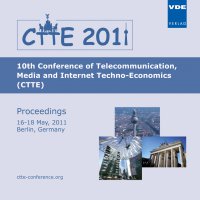Comparing FTTH Access Networks based on P2P and PMP Fibre Topologies
Conference: CTTE 2011 - 10th Conference of Conference of Telecommunication, Media and Internet Techno-Economics
05/16/2011 - 05/18/2011 at Berlin, Germany
Proceedings: CTTE 2011
Pages: 9Language: englishTyp: PDF
Personal VDE Members are entitled to a 10% discount on this title
Authors:
Jay, Stephan; Neumann, Karl-Heinz; Plückebaum, Thomas (Cost Modelling and Internet Economics, WIK-Consult GmbH, Bad Honnef, Germany)
Abstract:
There is an ongoing discussion in the market which NGA architecture best suits future needs, which investment and cost differences do exist and to which part they may contribute to the overall result. The discussion can be subsumed as P2P vs. GPON, which is somewhat misleading as our study reveals. The discussion is driven by the fact that the high capital cost and the long asset life time of fibre mean that the technology choices made today will dictate the opportunities for telecommunication business of all market players, incumbents, competitors, content providers and business and residential users for many years in the future. All FTTH architectures offer higher bandwidth per end customer than today, but differ in absolute bandwidth values and also may slightly differ in quality caused by different overbooking behavior. These differences take place not only in the incumbent’s network, who is deploying the NGA network, but also in the competitors’ networks relying on the wholesale products of the incumbent. There are already different opportunities in the type of the products (physical unbundled fibre lines or bitstream), but also in the locations where to access the wholesaler's network. Access at the Metropolitan Point of Presence (MPoP) can be given in a physically unbundled manner or as bitstream only, depending on the underlying fibre topology (fibre point-to-point (P2P) or fibre point-to-multi-point (PMP)). There could also be differences caused by weak or strong regulation or by the method wholesale prices are calculated, e.g. based on LRIC and current cost in a greenfield or on historic cost in a brownfield approach, where existing ducts are considered with a reduced amount of investment. WIK-Consult analyzed the cost and their differences between fibre FTTH network architectures and their related different wholesale approaches by using the well-known and understood steady state approach we have applied in other NGA analyses in the past. We expanded this by a dynamic cost consideration taking into account the different investment behavior of the FTTH architectures over time. Our results describe investment and cost differences between architectures, incumbents and wholesale based competitive operators. We clustered our analysis in geo types of decreasing population density. The concept of the critical market share describes the market share required by an operator in order to become profitable in a given cluster. Thus we describe the coverage a profitable national roll may achieve without subsidies.


